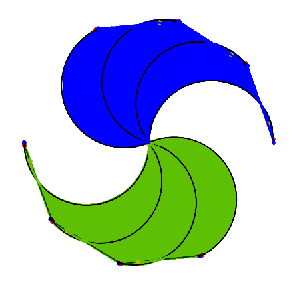2. The Top View
The first, and easiest, part of modeling the Twisted Savonius wind turbine is making a 2 dimensional top view. The twist of the turbine is constrained as theta the rotation of the turbine is X (which allows us to animate the turbine as if it’s spinning in the wind) and s and t are represent how far up and around the blade a certain pair of points are. We can “fill in” the entire blade by constructing traces. Traces are essentially the path along which a certain line, curve, locus, etc. moves traced out a given number of times through a certain interval. In other words they are a parameterized collection of lines and curves. These parameters all stay consistent between the different models and the traced surfaces method is used in the side view model also. Note that in this project I assume that the Savonius wind turbine’s blades have a semicircular cross section (horizontally). This is often the case with Savonius turbines but some have cross sections that are more elliptical. The top view model is ideal for calculating equations regarding the blade’s geometry, as it is more accurately defined mathematically than the side view models. The entire construction process, along with observations on the completed model is shown and annotated in the following video:

An Extended Version of the Top View Model, with three separate sections (more on sections in chapter 4)
As is observed in the video, there is an interesting geometric theorem that is found by constructing this model. In the next section, we will work through the geometric proof of this theorem.
| Previous | Next |
